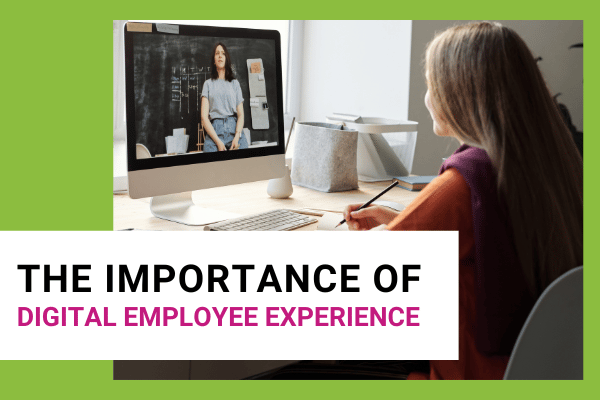When the pandemic first hit, many companies were forced to work remotely overnight. Without any precedent or warning, HR and IT departments had to find ways to adapt their internal systems and make it work.
However, now that we’re two years post-pandemic and many companies are committing to either remote or hybrid arrangements, leaders are forced to address the Digital Employee Experience for the first time.
What is digital employee experience?
What is Digital Employee Experience? Digital Employee Experience (DEX) refers to an employee’s overall experience with the digital workplace tools and technology provided by their company. This includes webmail services, project management software, instant message platforms, learning and training portals, HR systems, laptops, phones, and more. In short, Digital Employee Experience is the sum of the User Experience (UX ) for your organization’s internal applications and technology infrastructure.
DEX is a key component of the modern employee experience and can impact productivity, engagement, retention, and profitability. According to NextThink research, 77% of HR & IT leaders think that poor or unreliable IT services and equipment play a significant role in employee burnout or turnover. When remote employees feel disconnected from their companies or frustrated with ineffective tools, they’re more likely to lose motivation and disengage.
Just as you would optimize your digital customer experience, you need to improve each digital touchpoint with your employees to create a trusted relationship.
It’s not enough to provide your teams with the programs and machines they need to succeed. You’ve got to make sure that your digital tools are easily accessible, up-to-date, customizable, and interconnected wherever possible.
Do your employees have to create separate logins for each platform they use, or can they apply a single sign-on tool so they never have to reset another password? Is your company utilizing many platforms just for the sake of it, or does each program actually add value to your business? Can employees access their documents from anywhere they choose to work? These are just a few of the questions your company should be asking when it comes to evaluating your digital employee experience.
Aside from eliminating unnecessary stress and frustration for your employees, what are the biggest benefits to a strong digital employee experience? Let’s take a look:
1. It increases productivity
When employees are equipped with intuitive digital tools that make their jobs easier, they tend to be more productive and therefore more engaged at work. It seems like common sense, and yet according to Forrester Research, only 34% of companies say that they’ll be able to support fully remote or hybrid work needs in the next two years with their current capabilities.
When your platforms don’t offer self-service options to fix tech issues, your IT department ends up wasting much of its time on common problems. Raise your hand if you’ve ever called IT and they told you to restart your computer and magically your problem was fixed?! 🙋♀️ According to the Forrester report, 55% of respondents claimed that only 10% of their service tickets are solved through self-service. By ensuring your employees have the ability to fix or troubleshoot their own issues, you can reduce their distractions and eliminate unnecessary work for your IT department. The ultimate win-win!
In addition to properly functioning technology (which is the bare minimum!) your digital tools should be customizable for all of your employees’ preferences. Does your project management software offer multiple viewing settings for different organizational styles? Can your employees set their own active working hours, status messages, and notification preferences? When the line between home and work is already blurred for remote employees, the ability to set personal boundaries can increase well-being and ultimately productivity.
2. It provides greater flexibility for employees
With the right digital systems in place, your employees can seamlessly switch between the office or their home without any gaps in technology. I remember a time when I was working in-person for an agency. In order to finish some work from home later at night, I had to grab certain documents off the company’s server and drag them onto my desktop before leaving the office. Now, with cloud-based software, employees can easily access their files no matter where they are.
Lee Arthur, the Managing Director of the NY Institute of Finance, had to address his company’s DEX when 50% of the staff became permanently remote. Without access to their desk phones, employees were having a harder time connecting with their colleagues and customers.
Now, they use DialPad, a cloud-based communications network that allows users to access their calls and messages from anywhere. By eliminating desk phones, NY Institute of Finance immediately saved $45,000 and estimates that they will continue to save about $20,000 per year in operating costs.
3. It increases employee collaboration
With so many employees working from home, it’s harder to stay in touch with other teams within your organization. Because of this, so many departments end up working in silos. Are you relying on company-wide emails and Zoom meetings to disseminate important information, ideas, and status updates?
With a focus on digital employee experience, companies can implement communication platforms that foster collaboration. Digital programs can allow employees to join group conversations based around similar interests, task forces, or specific projects. Moreover, when your communication platforms seamlessly integrate with your other tools, employees can easily share documents and multimedia presentations and work together.
To take it a step further, MangoApps helps companies improve their digital employee experience with employee profiles. Employees can create their own profile pages with pictures, bios, work history, and more. New employees can quickly put faces to names and connect with their colleagues on a more personal level. As a virtual employee, it can feel unnatural to constantly communicate with someone without ever knowing who they really are. Advanced digital platforms like Mango can unite teams and help colleagues build relationships in ways that email or instant message can’t.
4. It shows your employees that you care about them
As Ari Weinzweig once said, “If you don’t create a great, rewarding place for people to work, they won’t do great work.” This doesn’t just apply to physical offices, but your digital workspaces, too. Superfandom is a two-way street. If you want your employees to care about your company, you’ve got to care about them first.
One of the easiest ways to show your employees you care is by trying to make their jobs as easy as possible. When you provide them with the most up-to-date technology and the budget for premium digital services, they’ll feel supported and empowered to do their best work.
Moreover, by prioritizing a strong digital employee experience, you’re showing your employees that you value their time and want to ensure an efficient and stress-free environment for them.
Forrester research shows that 71% of respondents are actively working to improve their DEX to support their remote staff. Your company must prioritize the digital employee experience if you want to be able to retain talent and lead an engaged workforce.
Not sure where to start? Take a look at your user-adoption metrics for your digital tools and survey your employees on their satisfaction with your offerings. With consistent feedback from your team, you can identify the biggest pain points in your technology setup and make improvements accordingly.
By using employee feedback, delivering a seamless experience, and offering personalized service, you can optimize your digital employee experience.
What are your favorite digital tools you’ve used at work to improve your DEX? Let me know!





